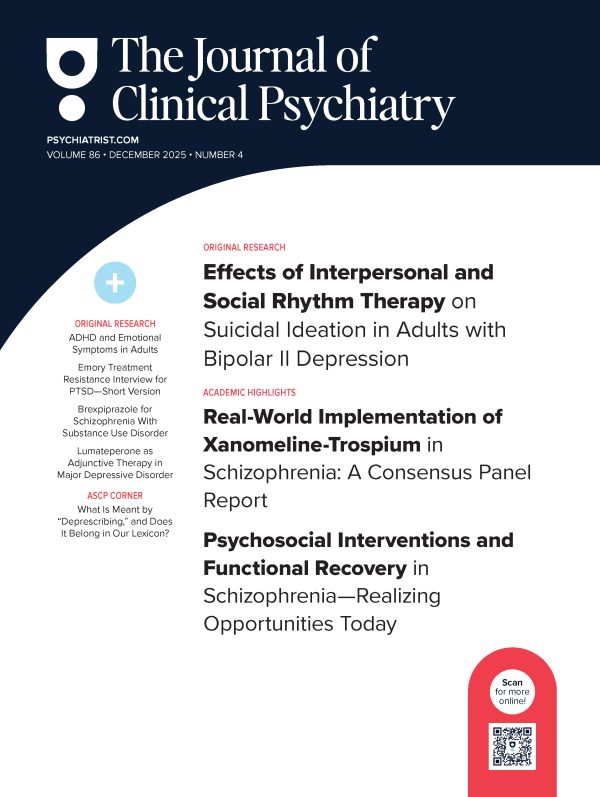Abstract
Objective: This study examines the durability (defined as time between treatments) of intravenous ketamine (IV-KET) and intranasal esketamine (IN-ESKET) for treatment-resistant depression (TRD), in a real-world clinical setting with repeated ketamine/esketamine maintenance therapy.
Methods: This was a single-center, observational study of adults with TRD who completed acute-phase treatment between August 17, 2017, and June 24, 2021, and received IV-KET (0.5 mg/kg) or IN-ESK (56/84 mg) maintenance therapy. Maintenance cycle duration was measured from the first treatment after the acute phase to the final treatment. Depressive symptoms were assessed using the Quick Inventory of Depressive Symptomatology before each treatment. Linear mixed-effects models and generalized linear mixed models (GLMM) evaluated treatment effects. The number of days between treatments (treatment intervals) was modeled using a negative binomial GLMM.
Results: Fifty-six maintenance cycles from 38 patients were included. The median baseline age was 46.2 years (78.9% female). Sixty-eight percent (n = 26) received IV-KET, and 32% (n = 12) received IN-ESKET. The median duration of the longest maintenance cycle was 61 weeks for IV-KET and 48 weeks for IN-ESKET, with 14 and 28 median treatments, respectively. IV-KET patients had longer intervals between treatments compared to IN-ESKET (incidence rate ratio: 1.75, P < .001). Mean treatment intervals were 18.9 days for IV-KET vs 10.8 days for IN-ESKET. Both treatments showed stable systolic blood pressure trajectories.
Conclusion: This study provides evidence regarding longer durability of IV-KET compared to IN-ESKET. These findings need to be replicated in larger prospective studies and confirmed in a randomized controlled trial comparing these two treatment interventions.
J Clin Psychiatry 2025;86(3):25m15831
Author affiliations are listed at the end of this article.
Members Only Content
This full article is available exclusively to Professional tier members. Subscribe now to unlock the HTML version and gain unlimited access to our entire library plus all PDFs. If you’re already a subscriber, please log in below to continue reading.
References (22)

- Berman RM, Cappiello A, Anand A, et al. Antidepressant effects of ketamine in depressed patients. Biol Psychiatry. 2000;47(4):351–354. PubMed CrossRef
- Singh B. Ketamine and esketamine for depression in daily practice: opportunities and challenges. J Clin Psychopharmacol. 2024;44(5):451–455. PubMed CrossRef
- Kim J, Farchione T, Potter A, et al. Esketamine for treatment-resistant depression - first FDA-Approved antidepressant in a new class. N Engl J Med. 2019;381(1):1–4. PubMed CrossRef
- SPRAVATO® (esketamine) approved in the U.S. as the first and only monotherapy for adults with treatment-resistant depression. Accessed January 22, 2025. https://www.jnj.com/media-center/press-releases/spravato-esketamine-approved-in-the-u-s-as-the-first-and-only-monotherapy-for-adults-with-treatment-resistant-depression
- Singh B, Vande VJL, Frye MA, et al. Can ketamine be a safe option for treatment-resistant bipolar depression? Expert Opin Drug Saf. 2022;21(6):717–720.
- Daly EJ, Trivedi MH, Janik A, et al. Efficacy of esketamine nasal spray plus oral antidepressant treatment for relapse prevention in patients with treatment-resistant depression: a randomized clinical trial. JAMA Psychiatry. 2019;76(9):893–903. PubMed CrossRef
- Sakurai H, Jain F, Foster S, et al. Long-term outcome in outpatients with depression treated with acute and maintenance intravenous ketamine: a retrospective chart review. J Affect Disord. 2020;276:660–666. PubMed CrossRef
- Wilkinson ST, Katz RB, Toprak M, et al. Acute and longer-term outcomes using ketamine as a clinical treatment at the Yale Psychiatric Hospital. J Clin Psychiatry. 2018;79(4):17m11731. PubMed CrossRef
- Archer S, Chrenek C, Swainson J. Maintenance ketamine therapy for treatment-resistant depression. J Clin Psychopharmacol. 2018;38(4):380–384. PubMed CrossRef
- Li W, Zhou Y, Liu W, et al. Long-term outcomes of repeated ketamine infusions in patients with unipolar and bipolar depression: a naturalistic follow-up study. J Affect Disord. 2022;300:172–178. PubMed CrossRef
- Singh B, Kung S, Pazdernik V, et al. Comparative effectiveness of intravenous ketamine and intranasal esketamine in clinical practice among patients with treatment-refractory depression: an observational Study. J Clin Psychiatry. 2023;84(2):22m14548. PubMed CrossRef
- d’Andrea G, Pettorruso M, Di Lorenzo G, et al. The rapid antidepressant effectiveness of repeated dose of intravenous ketamine and intranasal esketamine: a post-hoc analysis of pooled real-world data. J Affect Disord. 2024;348:314–322. PubMed
- Gutierrez G, Swainson J, Ravindran N, et al. IN Esketamine and IV Ketamine: results of a multi-site observational study assessing the effectiveness and tolerability of two novel therapies for treatment-resistant depression. Psychiatry Res. 2024;340:116125. PubMed CrossRef
- Nikayin S, Rhee TG, Cunningham ME, et al. Evaluation of the trajectory of depression severity with ketamine and esketamine treatment in a clinical setting. JAMA Psychiatry. 2022;79(7):736–738. PubMed CrossRef
- Singh B, Kung S, Vande Voort JL. Intravenous (IV) ketamine versus intranasal esketamine for depression—advantage IV ketamine? J Affect Disord. 2024;356:564–567. PubMed CrossRef
- Singh B, Bobo WV, Rasmussen KG, et al. The association between body mass index and remission rates in patients with treatment-resistant depression who received intravenous ketamine. J Clin Psychiatry. 2019;80(6):19l12852. PubMed CrossRef
- Vande Voort JL, Morgan RJ, Kung S, et al. Continuation phase intravenous ketamine in adults with treatment-resistant depression. J Affect Disord. 2016;206:300–304. PubMed CrossRef
- Rush AJ, Trivedi MH, Ibrahim HM, et al. The 16-Item Quick Inventory of Depressive Symptomatology (QIDS), clinician rating (QIDS-C), and self-report (QIDS-SR): a psychometric evaluation in patients with chronic major depression. Biol Psychiatry. 2003;54(5):573–583. PubMed CrossRef
- Kumar R, LeMahieu AM, Stan MN, et al. The association between thyroid stimulating hormone and depression: a historical cohort study. Mayo Clin Proc. 2023;98(7):1009–1020. PubMed CrossRef
- Niciu MJ, Meisner RC, Carr BR, et al. National Network of Depression Centers position statement: insurance coverage for intravenous ketamine in treatment-resistant major depressive disorder. J Affect Disord. 2024;346:221–222. PubMed CrossRef
- Wilkowska A, Cubała WJ. The downstaging concept in treatment-resistant depression: spotlight on ketamine. Int J Mol Sci. 2022;23(23):14605. PubMed CrossRef
- Wei Y, Chang L, Hashimoto K. Molecular mechanisms underlying the antidepressant actions of arketamine: beyond the NMDA receptor. Mol Psychiatry. 2022;27(1):559–573. PubMed CrossRef





